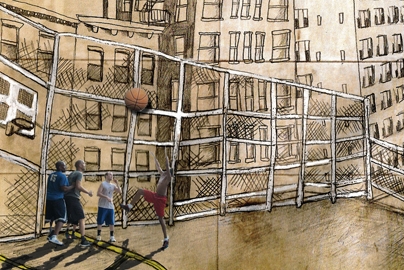As an American teenager it’s not easy to escape high school without suffering through countless cheesy metaphors maintaining the relevance of sports to life. For this reason I generally eschew sports themed anything, be it movies, art, or theater. This week, I’m truly glad I made an exception. Wednesday I attended the opening of “Horatio”, a new multimedia performance piece playing until the 18th at Here in Tribeca. “Horatio” is the theatrical counterpart to a documentary of the same name which is scheduled for release next year. Both pieces focus on the Corporal John A. Seravelli Playground, also known as Horatio, perhaps New York’s most famous public basketball court.
Horatio’s creators wove footage from the documentary in and out of a stage performance by Jarett Karlsberg and Michael Borne. Both actors took on the difficult job of switching between three roles each. The plot itself was a study in form meets function, organized seamlessly as according to a 3 on 3 basketball game. Monologues, character introductions, and multimedia sequencing unfolded according to the logic of the game.
Though “Horatio” is ostensibly about basketball, what is at stake is much larger. Through lead characters Tony Dapoloto and Mike Seravalli we come to understand the dynamics of the court. Tony is a young real estate agent from New Jersey. Mike is a local who has played at Horatio almost every day for close to 20 years. The court functions as a social space and becomes a medium for interpreting the changing dynamics of a quickly gentrifying area. Here a Wall Street executive, a real estate agent, a construction worker and a bus driver have cause for interaction. Newcomers mix with locals, communicating through a common idiom learnt within the confines of the park. Towards the end of the show Horatio itself becomes the topic of discussion. Mike and Tony heatedly debate the importance of the park. Tony avidly supports a proposed re-development of the park. At the idea of having his sanctuary turned into luxury condos Mike becomes hostile.
This is the strength of the show; it reveals the broader social tensions at play within the city itself. The audience comes to feel the emotional consequences of change. In sympathizing with the characters, we understand that nothing is simple, not even basketball.
Created by Ely Key, Antonguilio Panizzi, and Samuel Smith-Stevens.


 RSS
RSS
